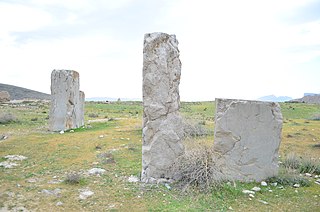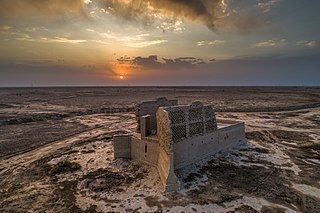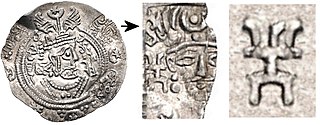
Yazdegerd III was the last Sasanian King of Kings of Iran from 632 to 651. His father was Shahriyar and his grandfather was Khosrow II.

The Muslim conquest of Persia, also known as the Arab conquest of Iran, was carried out by the Rashidun Caliphate from 633 to 654 AD and led to the fall of the Sasanian Empire as well as the eventual decline of the Zoroastrian religion.

Istakhr was an ancient city in Fars province, five kilometres north of Persepolis in southwestern Iran. It flourished as the capital of the Persian Frataraka governors and Kings of Persis from the third century BC to the early 3rd century AD. It reached its apex under the Sasanian Empire, and was the hometown of the Sasanian dynasty. Istakhr briefly served as the first capital of the Sasanian Empire from 224 to 226 AD and then as principal city, region, and religious centre of the Sasanian province of Pars.

The Battle of Nahavand, also spelled Nihavand or Nahawand, was fought in 642 between the Rashidun Muslim forces under caliph Umar and Sasanian Persian armies under King Yazdegerd III. Yazdegerd escaped to the Merv area, but was unable to raise another substantial army. It was a victory for the Rashidun Caliphate and the Persians consequently lost the surrounding cities including Spahan (Isfahan).

Sakastan was a Sasanian province in Late Antiquity, that lay within the kust of Nemroz. The province bordered Kirman in the west, Spahan in the north west, Kushanshahr in the north east, and Turan in the south east. The governor of the province held the title of marzban. The governor also held the title of "Sakanshah" until the title was abolished in ca. 459/60.
Al-Ala al-Hadrami was an early Muslim commander and the tax collector of Bahrayn under the Islamic prophet Muhammad in c. 631–632 and Bahrayn's governor in 632–636 and 637–638 under caliphs Abu Bakr and Umar. Under Abu Bakr, al-Ala suppressed a rebellion by a scion of the pro-Sasanian Lakhmid dynasty as part of the Ridda wars. Under Umar, he launched naval expeditions against the Sasanians, the last of which ended in disaster for the Arabs and was the cause of his dismissal. He was last appointed governor of Basra but died on his way there to assume office.
Uthman ibn Abi al-As al-Thaqafi was a companion of the Islamic prophet Muhammad from the tribe of Banu Thaqif and the governor of Bahrayn and Oman in 636–650, during the reigns of caliphs Umar and Uthman. During his governorship he led military campaigns against the Sasanian Persians in Fars. After his dismissal, he settled with his brothers in Basra where he was granted a large estate by the caliph. He transmitted numerous hadiths to the scholar al-Hasan al-Basri and died in the city.

Ardashir-Khwarrah was one of the four administrative divisions of the Sasanian province of Pars. The other administrative divisions were Shapur-Khwarrah, Istakhr and Darabgerd, while a fifth named Arrajan was founded in the early 6th century by Kavadh I.

Sistān, known in ancient times as Sakastān, is a historical and geographical region in present-day Eastern Iran and Southern Afghanistan. Largely desert, the region is bisected by the Helmand River, the largest river in Afghanistan, which empties into the Hamun Lake that forms part of the border between the two countries.
Abū ʿAbd al-Raḥmān ʿAbd Allāh ibn ʿĀmir ibn Kurayz (626–678) was a Rashidun politician and general, serving as governor of Basra from 647 to 656 AD during the reign of Rashidun Caliph Uthman ibn Affan. He was a cousin of the Caliph through his father. He is known for his administrative and military prowess including his successful campaigns of reconquest and pacification of former territories of the Sasanian Empire in what is now Iran and Afghanistan.

Hormuzan was a Persian aristocrat who served as the governor of Khuzestan, and was one of the Sasanian military officers at the Battle of al-Qādisiyyah. He was later taken prisoner by the Muslims after the fall of Shushtar in 642. Two years later, he was accused of the assassination of the Rashidun caliph Umar, and was killed by 'Ubaid-Allah, the deceased caliph's son.

Sistani Persians are a Persian ethnic group, who primarily inhabit Sistan in southeastern Iran and historically southwestern Afghanistan as well. Their descendants in Afghanistan are primarily the Pashtun tribe of the Sakzai who are the largest ethnicity in the Southwestern parts of Afghanistan.
The Battle of Badghis was fought in 654 between the Karen family and their Hephthalite allies against the Rashidun Caliphate.

The siege of Shushtar was fought from 641 to 642 between the Sasanian Empire and the invading Arab Muslims of the Rashidun Caliphate. Shushtar was an ancient strong stronghold in Khuzestan, and was attacked by the Arabs under their commander Abu Musa Ashaari. Although the city managed to resist the Arabs, the Sasanians later faced desertion, which resulted in the Arabs capturing the city and capturing its commander, Hormuzan.
The Battle of Bishapur took place during the Muslim conquest of Fars, a province of Persia, in the seventh century AD. The city was taken by the Muslim Rashidun forces after a siege.
Rabi ibn Ziyad al-Harithi was an Arab military leader, who served the Rashidun and Umayyad Caliphates.
Shahrag was an Iranian aristocrat, who served as the governor of Pars during the Arab invasion of Iran.
The Asawira were a military unit of the Rashidun and Umayyad Caliphate. The unit consisted of Iranian noblemen who were originally part of the aswaran unit of the Sasanian army. It was disbanded in 703 by al-Hajjaj ibn Yusuf.

Pars was a Sasanian province in Late Antiquity, which almost corresponded to the present-day province of Fars. The province bordered Khuzestan in the west, Kirman in the east, Spahan in the north, and Mazun in the south.

Nezak Tarkhan was a nomadic ruler of Tokharistan who led a revolt against the Arab commander Qutayba bin Muslim around 709 CE.











